Recent Articles
Popular Makes
Body Types
2017 Subaru Forester Road Test and Review
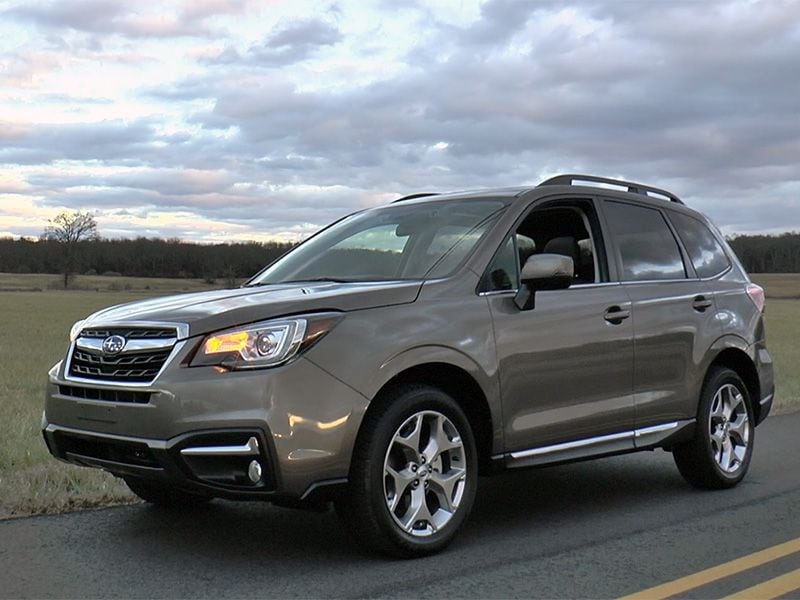
2017 Subaru Forester 3 4 front profile ・ Photo by Dan Gray
The Subaru Forester has been freshened for 2017, with light revisions to the exterior and a significant upgrade to the interior. The changes are strategic. All-wheel-drive Subaru wagons always have been a thrifty alternative to conventional SUVs and tend to hold their value extremely well. Part of this phenomena is due to intentional scarcity. The company maintains a tight ship, with production inventories tied closely to sales and a highly productive dealer network. Bloomberg states that Subaru has “the best profit margin in the industry.” There are approximately 600 Subaru dealerships in the United States. Compare that to Toyota with over 1200 dealerships and Ford with over 3200 (including Lincoln). Subaru knows its customers well and is not one to follow fashion or whim.
Exterior Styling
The 2017 model year brings refinement to the Forester’s exterior. The front end receives a new bumper treatment (2.5i models only) and hexagonal grille, along with redesigned headlamps, while the rear end receives new LED tail lamps. Our 2.5i Touring test vehicle was finished in Sepia Bronze Metallic, which is a new color for 2017 and exclusive to the Touring trim level. The Forester’s tall greenhouse glass benefits outward vision, and its overall look is for more wagon-like and utilitarian than the Mazda CX-5, Hyundai Tucson, or Kia Sorento. New wheels spice things up a bit. The 2.5i Touring rides on 18 x 7-inch alloys wrapped in 225/55R-18 all-season tires, while the Premium and Limited models are fitted with 17 x 7-inch alloys and 225/60/R-17s.
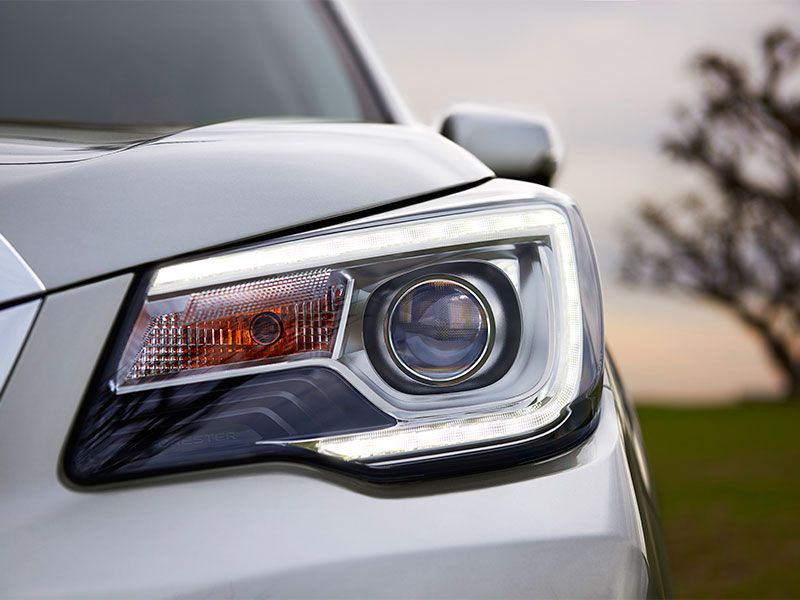
Photo by Subaru
Trim Levels
The 2017 Subaru Forester is available in five models, with two engine choices. The 2.5i is offered in base ($22,595), Premium ($25,495), Limited ($29,195), and Touring ($31,295) trim levels, while the more performance-oriented Forester 2.0XT is offered in Premium ($29,295) and Touring ($34,295). A panoramic moonroof is included in all trim levels, except for the base model. XT models feature a sport-tuned suspension, with higher spring rates and special chassis reinforcements, along with larger vented disc brakes all around. If you hanker for a leather-appointed interior, opt for the Limited or Touring trim levels.
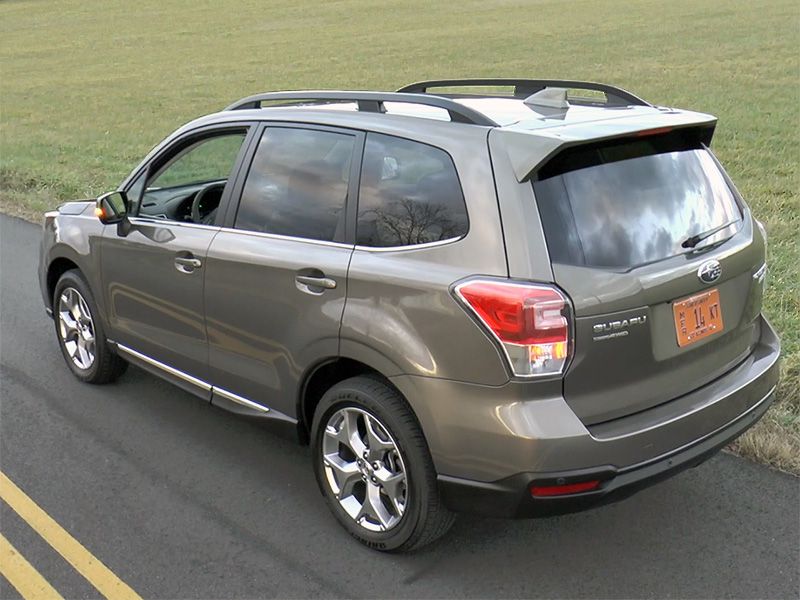
Photo by Dan Gray
Powertrain
The 2017 Forester 2.5i is powered by a naturally aspirated 2.5-liter Subaru boxer engine. The horizontally opposed 4-cylinder powerplant uses sequential multi-port fuel injection to produce 170 horsepower and 174 lb.-ft. of torque. The range-topping Forester 2.0XT is fitted with a 2.0-liter turbocharged and direct-injected flat-4 that delivers 250 horsepower and 258 lb.-ft. of torque. A 6-speed manual transmission is standard on the 2.5i and 2.5i Premium trim levels, but is not offered on the 2.0XT. A continuously variable transmission (CVT) is offered on all the 2.5i models and is standard on the 2.0XT. All Foresters are equipped with Subaru’s well-proven Symmetrical all-wheel drive.

Photo by Dan Gray
Fuel Economy and Performance
The Forester 2.5i Touring’s fuel-efficiency has improved over 2016 and is significantly better than the Toyota RAV4 Platinum AWD and Ford Escape Titanium AWD. The Forester 2.5i is EPA-rated at 22 mpg city/29 mpg highway with the 6-speed manual transmission and 26/32 with the CVT; the turbocharged Forester 2.0XT is rated at 23/27. While the 2.5-liter boxer engine is designed to run on regular unleaded, 93-octane premium fuel is recommended (but not required) for the turbocharged 2.0-liter XT engine. Lower octane fuel will negatively affect performance and efficiency. All Foresters are equipped with a 15.9-gallon fuel tank and have a 1500-pound towing capacity. Our 2.5i Touring model hit 60 mph in about nine seconds; the turbocharged 2.0XT should slash that time by nearly a third.
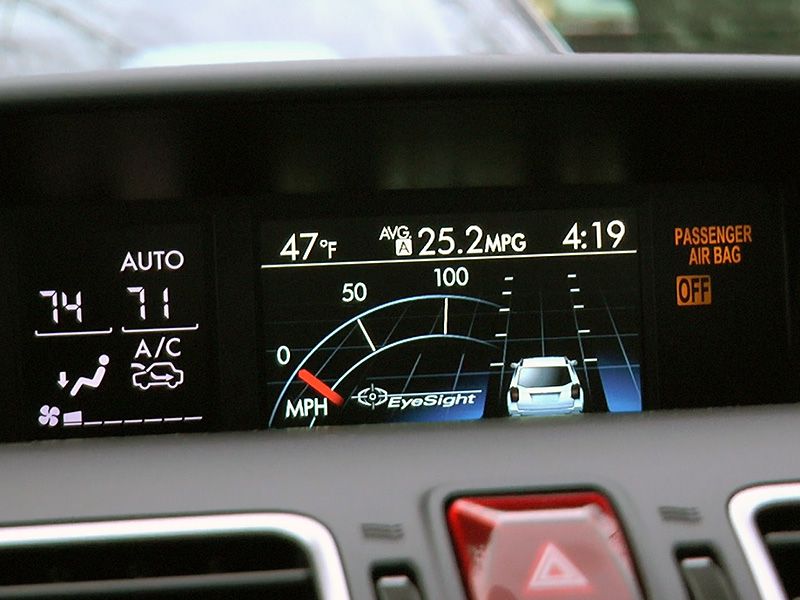
Photo by Dan Gray
Safety Technology
The Forester can be equipped with a full suite of safety technology, including blind-spot mirrors and rear cross-traffic alert. Subaru’s EyeSight safety technology package is offered as an option on the 2.5i Premium, Limited, and Touring, as well as the 2.0XT Touring. The EyeSight package includes a pre-collision braking system, adaptive cruise control, and lane-departure warning with sway warning and lane-keep assist. Automatic high-beam headlights and reverse automatic braking are offered on the Limited and Touring models. The Insurance Institute for Highway Safety (IIHS) rates the 2017 Subaru Forester as a Top Safety Pick+ when it's equipped with the front crash prevention system and LED steering responsive headlights, which enhance the lighting around curves.
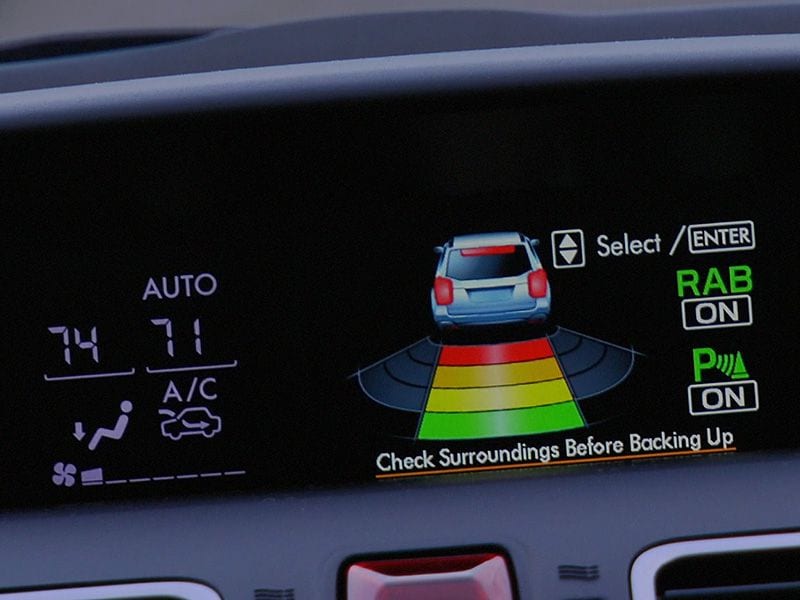
Photo by Dan Gray
Interior
The 2017 Forester’s interior is roomy and nicely appointed, across the range. All models are fitted with standard heated front bucket seats, with the exception of the base 2.5i and 2.5i Premium. The 2.5i is the only Forester not equipped with a 10-way power-adjustable driver seat with lumbar support. The Limited and Touring models are fitted with perforated leather upholstery, and the Touring models have heated steering wheels (never before offered in the Forester). Our tester’s saddle brown leather interior was quite handsome. The Forester's front seat provides 40.0 inches of headroom, 43.0 inches of legroom, and 57 inches of shoulder room, while the back seat provides 37.5 inches of headroom, 38.0 inches of legroom, and 56.5 inches of shoulder room.

Photo by Dan Gray
Infotainment
While Subaru’s Starlink infotainment system does not support Apple CarPlay or Android Auto like the Honda CR-V does, it provides iHeartRadio, Sticker, Aha, and Pandora app integration, along with Siri Eyes-Free. A 7-inch touchscreen Subaru Starlink infotainment system is standard in all 2017 Foresters, with the exception of the base model. The 2.5i Touring’s 8-speaker Harman Kardon audio system and 440-watt amplifier is a significant step up over the Premium and Limited’s 6-speaker system. A navigation system is included in the 2.5i’s only option package ($1595), which also features the complete EyeSight driver-assist technology package, along with reverse automatic braking, blind-spot mirrors, and rear cross-traffic alert. A three-year subscription to SiriusXM Traffic and Travel Link is included.
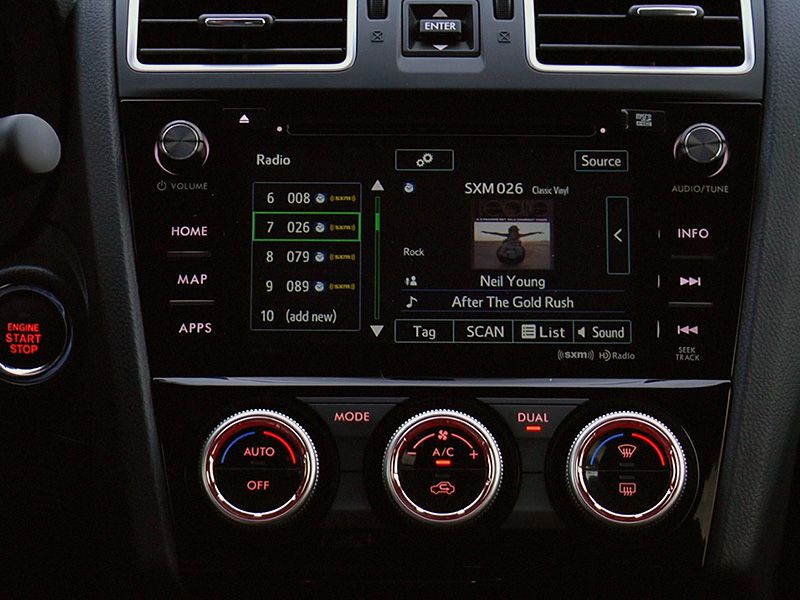
Photo by Dan Gray
Driving Impressions
The 2017 Subaru Forester towers over lesser crossovers with an ample 8.7 inches of ground clearance and is capable both on- and off-road. Handling is solid, the ride is smooth, and the cabin quiet thanks to additional under-floor insulation, thicker door glass, and a sound-insulated windshield. The electric-assist rack-and-pinion steering is quick, and the vehicle's 34.8-foot curb-to-curb turning circle is considerably tighter than that of the Toyota RAV4 (36.7) and Ford Escape (38.8). Pressing the X-Mode button optimizes the Forester Touring’s stability control, traction control, all-wheel drive, and hill-descent control for challenging road surfaces. The naturally aspirated 2.5-liter boxer engine offers quick throttle response and consistent power delivery on the roll. That said, the CVT in our tester felt a bit slow to engage off the line, and like most conventional CVTs it was subject to drone under heavy acceleration. Overall, the Forester 2.5i Touring is a low-stress pleasure to drive, wherever your voyage may take you.
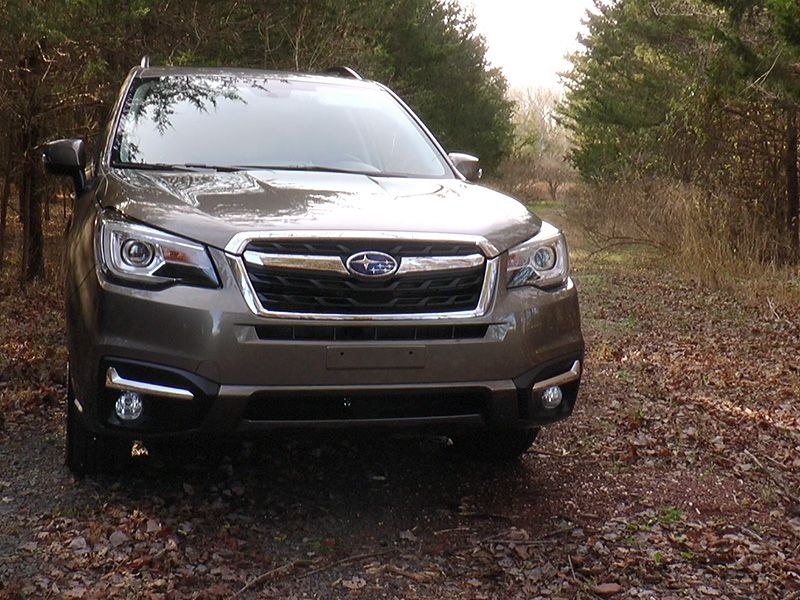
Photo by Dan Gray
Cargo
The base Forester’s cargo area provides 34.4 cubic feet of cargo capacity behind the rear seats and 74.7 cubic feet with the 60/40 rear seat backs folded down. Opting for the panoramic moonroof gobbles up a significant amount of space, lowering the cargo capacity to 31.5 and 65.5 cubic feet, respectively. The Forester trails the Homda CR-V, Nissan Rogue, Toyota RAV4, and Ford Escape with regard to cargo capacity, with the RAV4 leading the pack.
You’ll find welcome conveniences at the upper range. The Limited and Touring models feature a power rear liftgate and a removable cargo area tray, while the Touring model benefits from remarkably handy one-touch fold-down rear seat backs. A dealer-installed rear bumper cover ($98) wards off the inevitable cargo-loading scuffs.
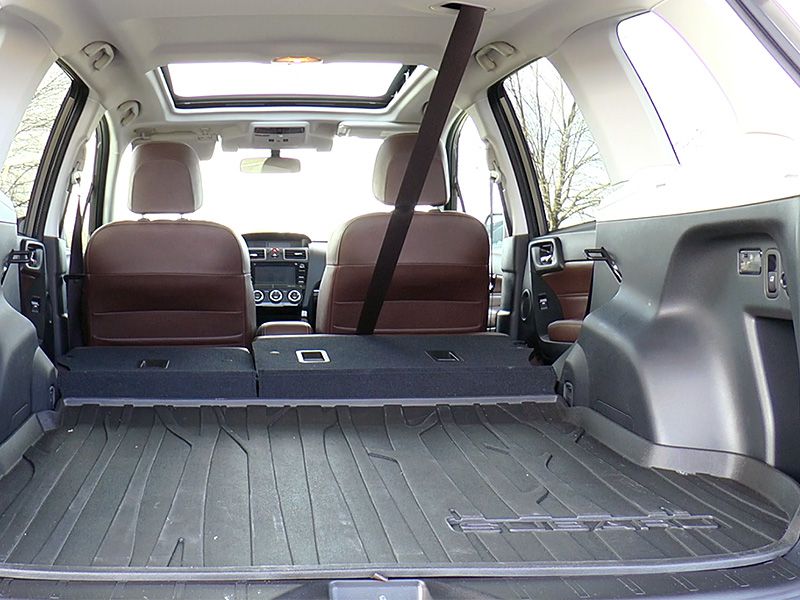
Photo by Dan Gray
Final Thoughts
The 2017 Subaru Forester faces intense competition from around the globe, but it remains an excellent choice. The segment-leading CR-V, RAV4, Rogue, and Escape have all been recently refreshed, and a revised Chevrolet Equinox is waiting in the wings, but standard all-wheel drive is always a trump card for Subaru in cold-weather states. (If a competitor’s MSRP looks low, you’ll want to make sure it’s an AWD model.) In long-term ownership costs, Subarus are usually a safe bet, with solid residual values. Reliability tends to be good and warranty periods are par with Toyota, Ford, and Nissan: 36 months/36,000 miles basic, 60 months/60,000 miles powertrain, and 60 months/unlimited miles rust perforation. While Hyundai and Kia have an uphill battle in this segment, they up the ante with exceptional 60/60,000 basic, 120/100,000 powertrain, and 84/Unlimited rust perforation warranties. The biggest question going forward is this: Will the new administration in Washington DC make good on its promise to raise taxes on imported vehicles? While Subaru builds the Legacy, Outback, and Impreza in Lafayette, Indiana, the Forester is exclusively built in Ota, Gunma, Japan.
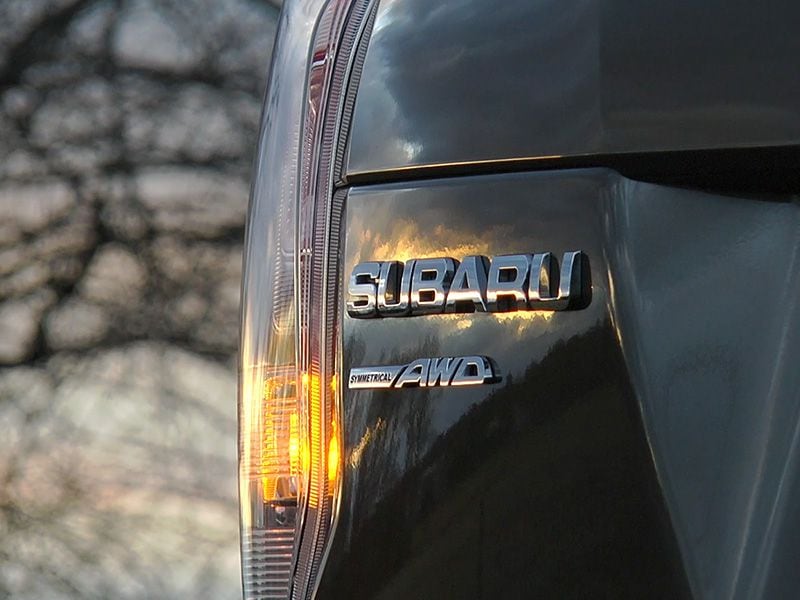
Photo by Dan Gray